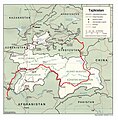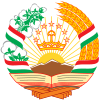The Tajikistan Portal
Tajikistan, officially the Republic of Tajikistan, is a landlocked country in Central Asia. Dushanbe is the capital and most populous city. Tajikistan is bordered by Afghanistan to the south, Uzbekistan to the west, Kyrgyzstan to the north, and China to the east. It is separated from Pakistan by Afghanistan's Wakhan Corridor. It has a population of approximately 10.6 million people. The territory was previously home to cultures of the Neolithic and the Bronze Age, including the city of Sarazm, and was later home to kingdoms ruled by people of various faiths and cultures including the Oxus civilization, Andronovo culture, Buddhism, Nestorian Christianity, Hinduism, Zoroastrianism, Manichaeism, and Islam. The area has been ruled by empires and dynasties including the Achaemenid Empire, Sasanian Empire, Hephthalite Empire, Samanid Empire, and Mongol Empire. After being ruled by the Timurid Empire and Khanate of Bukhara, the Timurid Renaissance flourished. The region was later conquered by the Russian Empire, before becoming part of the Soviet Union. Within the Soviet Union, the country's borders were drawn when it was part of Uzbekistan as an autonomous republic before becoming a constituent republic of the Soviet Union on 5 December 1929. (Full article...) Selected article -Tajikistan did not join in the World Bank until 1993. Before the collapse of USSR in 1991, Tajikistan was experiencing planned economy which was dominated by Moscow. Right after the dissolution, different from other nations which experienced a relatively stable transition from planned economy to market economy, Tajikistan fell into a serious civil war. As a result, the first mission after Tajikistan became the official member of the World Bank, was to recover its economy from bullets and blood. In 1997. $10 million credit was grant for Post-Conflict Rehabilitation Project. The proposed credit was used to conduct necessary imports and to restore production. Under different time periods, the World Bank and Tajikistan worked together in response to various problems. Later on, the economic crisis of 2008 caused the inflation of food prices in Tajikistan. In response to the crisis, the World Bank issued $6.25 million for the Emergency Food Security and Seed Imports Project in order to help at least 28000 households to release the food price pressure. Coming into the 21st century, Tajikistan received financing from IDA and IBRD of the World Bank with respect to programs of healthcare, education, irrigation and agriculture. Over the past years, Tajikistan has received over 130 projects of which 17 are active and a total of over $1.4 billion from the World Bank. With the help of those projects, from 2000 to 2017, the poverty rate in Tajikistan had been decreased from 83% to 29.5%. Besides, current GDP growth rate in Tajikistan is around 7%. Nevertheless, with a stable GDP growth rate, Tajikistan is still one of the poorest countries in Central Asia. (Full article...) Did you know? -SubcategoriesPreview warning: Page using Template:Div col with unknown parameter "1 = 2"; use colwidth= to specify column size
General imagesThe following are images from various Tajikistan-related articles on Wikipedia.
Related portalsReligions in Tajikistan Post Soviet states Other countries TopicsThings you can do
Selected image Credit: User:VargaA Dushanbe, Capital of Tajikistan
WikiProjectsAssociated WikimediaThe following Wikimedia Foundation sister projects provide more on this subject:
Discover Wikipedia using portals | ||||||||



















































